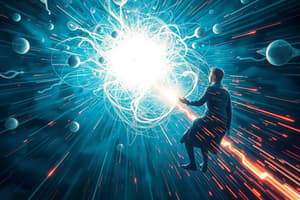Podcast
Questions and Answers
What is force?
What is force?
A force is a push or pull acting on a body which changes or tends to change the state of rest or of uniform motion. It's a vector quantity.
What is the SI/CGS unit of force?
What is the SI/CGS unit of force?
Newton/dyne
What is one newton?
What is one newton?
One newton is a force which, when acted upon a body of mass 1 kg, produces in it an acceleration of 1 m/s^2.
1 N is equal to how many dynes?
1 N is equal to how many dynes?
What is a balanced force?
What is a balanced force?
What is an unbalanced force?
What is an unbalanced force?
What is Newton's First Law of Motion?
What is Newton's First Law of Motion?
What is another name for Newton's First Law of Motion?
What is another name for Newton's First Law of Motion?
What is inertia?
What is inertia?
What is the measure of inertia of a body?
What is the measure of inertia of a body?
What is inertia of rest?
What is inertia of rest?
What is inertia of motion?
What is inertia of motion?
What is inertia of direction?
What is inertia of direction?
What is Newton's Second Law of Motion?
What is Newton's Second Law of Motion?
What is momentum?
What is momentum?
What is the SI unit of momentum?
What is the SI unit of momentum?
What does the equation v^2 - u^2 = 2as represent?
What does the equation v^2 - u^2 = 2as represent?
Frictional force is always?
Frictional force is always?
Give an application of Newton's Second Law.
Give an application of Newton's Second Law.
What are impulsive forces?
What are impulsive forces?
What is impulse?
What is impulse?
What is Newton's III Law?
What is Newton's III Law?
Give an example of Newton's Third Law of Motion.
Give an example of Newton's Third Law of Motion.
What is the Law of Conservation of Momentum?
What is the Law of Conservation of Momentum?
What is the formula for recoil velocity?
What is the formula for recoil velocity?
When is Newton's III Law applicable?
When is Newton's III Law applicable?
Flashcards are hidden until you start studying
Study Notes
Force
- Defined as a push or pull acting on a body, it can change the state of rest or uniform motion.
- Considered a vector quantity, it has both magnitude and direction.
Units of Force
- SI unit is the Newton (N), while the CGS unit is the dyne.
- One Newton is the force needed to accelerate a 1 kg mass at 1 m/s².
Force Conversions
- 1 N = 10^5 dynes.
Balanced and Unbalanced Forces
- Balanced forces do not change an object's state of rest or motion.
- Unbalanced forces result in a change in the state of an object.
Newton's First Law of Motion
- States that an object remains at rest or in uniform motion unless acted upon by an external force.
- Also known as the law of inertia.
Inertia
- Refers to an object's resistance to change in its state of rest or motion.
- Measured by mass, which quantifies the amount of inertia.
Types of Inertia
- Inertia of rest: A stationary object stays at rest; e.g., a passenger falling backward when a bus starts.
- Inertia of motion: A moving object stays in motion; e.g., a passenger leaning forward when the bus stops.
- Inertia of direction: An object's resistance to changing direction; e.g., falling to the left when a bus turns right.
Newton's Second Law of Motion
- The rate of change of momentum is directly proportional to the applied unbalanced force.
- Momentum (P) is the product of mass (m) and velocity (v); expressed as P = m*v, a vector quantity.
Momentum
- SI unit of momentum is kg·m/s.
Friction
- Frictional force is always negative, opposing the direction of motion.
Applications of Newton's Second Law
- High jump athletes land on cushioning to reduce impact.
- Karate experts use focused force to break materials.
- Seat belts are advised for car safety to restrain passengers.
Impulsive Forces and Impulse
- Impulsive forces act for a short time.
- Impulse equals force multiplied by time; SI unit is Newton-seconds (Ns).
Newton's Third Law of Motion
- States that for every action, there is an equal and opposite reaction, influencing different bodies.
Examples of Third Law of Motion
- A gun recoils upon firing a bullet.
- Swimming, walking, and rowing illustrate this law.
- Hitting a nail results in discomfort from reaction force.
Law of Conservation of Momentum
- In an isolated system, total momentum remains constant without external forces.
- Expressed as total initial momentum = total final momentum.
Recoil Velocity
- Calculated as V = -mv/M, where V is recoil velocity, M is the mass of the gun, and m is the mass of the bullet.
Applicability of Newton's Third Law
- Only valid when action and reaction forces act on different bodies.
Studying That Suits You
Use AI to generate personalized quizzes and flashcards to suit your learning preferences.




